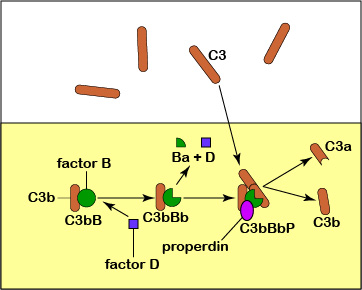
Activation of the alternative complement pathway begins when C3b (or C3 hydrolized by water) binds to the cell wall and other surface components of microbes. Alternative pathway protein factor B then combines with the cell-bound C3b to form C3bB. Factor D then splits the bound Factor B into Bb and Ba, forming C3bBb. A serum protein called properdin then binds to the Bb to form C3bBbP. C3bBbP functions as a C3 convertase that can enzymatically split hundreds of molecules of C3 into C3a and C3b.
Last updated: August, 2019
Please send comments and inquiries to Dr.
Gary Kaiser